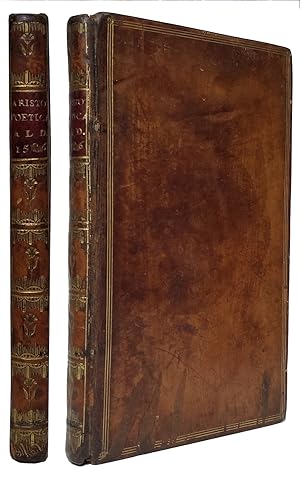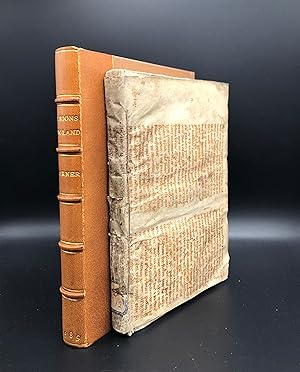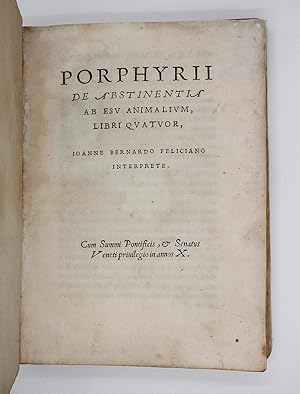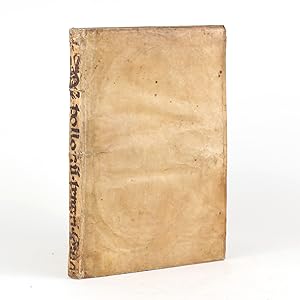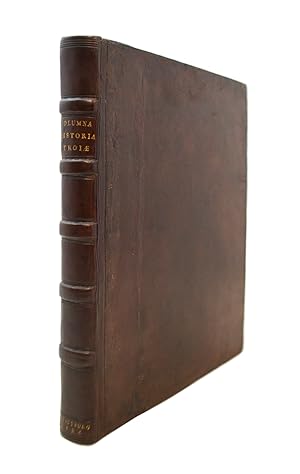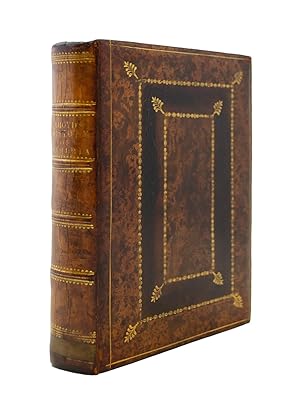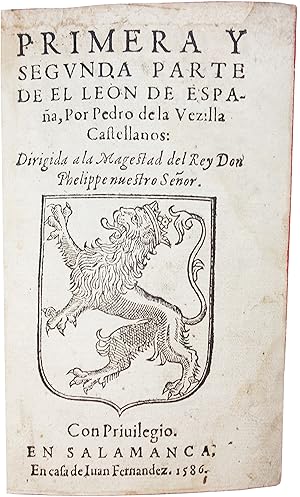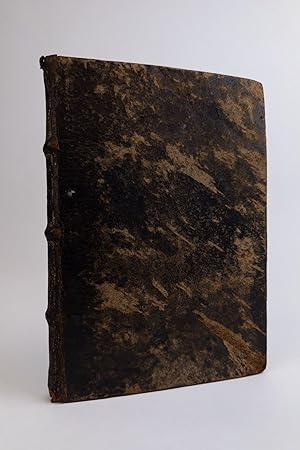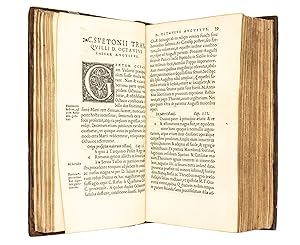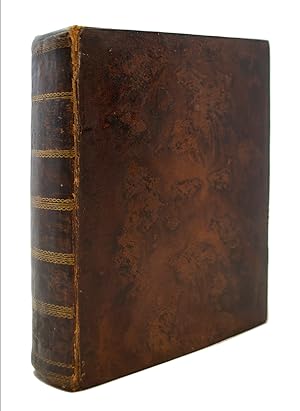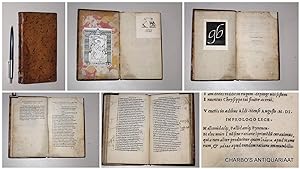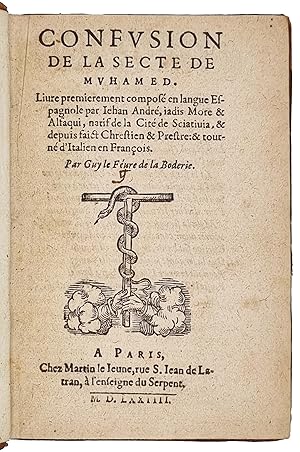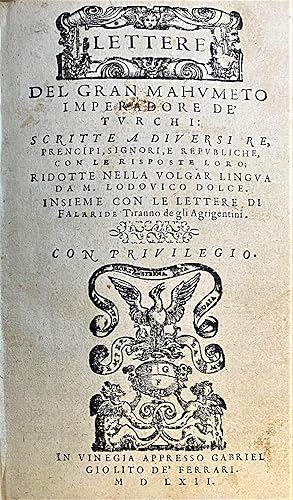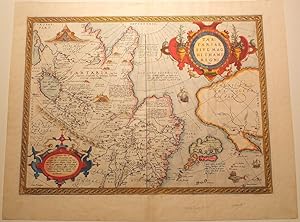fiction (Plus de 20 000 résultats)
Type d'article
- Tous les types d'articles
- Livres (20 965)
- Magazines & Périodiques (1)
- Bandes dessinées (2)
- Partitions de musique
- Art, Affiches et Gravures
- Photographies
- Cartes
-
Manuscrits &
Papiers anciens
Etat
Reliure
Particularités
- Edition originale (624)
- Signé (185)
- Jaquette (2 845)
- Avec images (18 025)
- Sans impression à la demande (20 967)
Pays
Evaluation du vendeur
-
The Discoverie of Witchcraft
Edité par [Henry Denham for] William Brome, London, 1584
Vendeur : Manhattan Rare Book Company, ABAA, ILAB, New York, NY, Etats-Unis
Edition originale
Early calf. Etat : Very Good. First edition. Extremely rare first edition of this far-reaching exposé that provoked King James, inspired Shakespeare and was the first significant work to document the secrets of illusion and the occult. A magnificent copy from the Biblioteca Lindesiana. The Discoverie of Witchcraft, written by Reginald Scot in 1584, upended many sixteenth-century beliefs in Britain about witches, superstition, spirits and magic. Scot proves that what was believed to be witchcraft was little more than illusion and delusion. Infuriated by a "ridiculous" 1581 witchcraft trial, Scot in The Discoverie challenges popular beliefs about dark magic, providing diagrams documenting the performance of staged illusions previously ascribed to witchcraft (Reid, "The Discoverie of Witchcraft"). The evidence presented in this pivotal work angered political and religious leaders, gave inspiration to literary masters of his era and contributed a blueprint to future generations of magicians and practitioners of the dark arts. Consulting hundreds of treatises in Latin and English, studying various scripture and visiting courts of law in districts where witchcraft prosecutions occurred, Scot collected evidence that witchcraft had neither rational nor religious basis. He asserted that the Biblical terms which had been translated as "witch" did not, in their original languages, share the associations ascribed to them in contemporary witchcraft discourse. Thus, one pillar of Scot's work is the undermining of the scriptural argument for the execution of witches -and further blaming the Catholic Church for encouraging dangerous superstitions. Scot also contends that spirits cannot take human form nor interact with humans, and consequently that the link between spells cast by so-called witches and any unpleasant events spuriously attributed to witches is entirely coincidental. As set out by one of Scot's recent biographers David Wootton, Scot explains the witch phenomenon as "resulting out of a particular type of social encounter: old women begging for food or other assistance would curse their neighbours when they were turned away empty handed; if something bad then happened - the death of a child, perhaps - the old woman would be taken to be a witch. Those who confessed to being witches were either deluded or the victims of torture. mere fable and fiction" (Wootton, "Scott [Scot], Reginald"). Published during the Scientific Revolution, Scot's lengthy and unrelenting work contributes to a period in which intellectuals were redefining rationality and questioning of old beliefs. Defying both church and state, he labels those who believed in witches as heretics and those who claimed to be witches as mentally ill. Read widely in the late sixteenth and early seventeenth centuries, The Discoverie of Witchcraft became an often-cited reference for those who doubted the existence of witchcraft. James VI, King of Scotland from 1567 to 1625 (and later King of England from 1603), was outraged by Scot's opinions and penned his objections in his 1597 Daemonologie. The three-book treatise, in which the King holds that witches are not only real but pose a substantial threat to the realm, is a defence of the practice of witchcraft prosecution and a guide for identifying and trying witches. Combined with his writings on a vast array of topics ranging from his views on poetry to his distaste for tobacco, James VI's response to rising scepticism towards the presence of witches in Britain (chief among them being Scot's Discoverie) is a central part in his project of text production throughout his reign -second only as an expression of his theology to his commission of the King James Bible, published in 1611. According to legend, on the occasion of his accession to the English throne in 1603, King James VI and I called for all copies of The Discoverie of Witchcraft to be destroyed. While there is no contemporary evidence to support this story, which first appeared in 1659, The Discoverie was continuousl.
-
De rerum natura libri sex. A Dionysio Lambino. locis innumerabilibus ex auctoritate quinque codicum manuscriptorum emendati, atque in antiquum ac nativum statum ferè restituti & praeterea brevibus, et perquàm utilibus commentariis illustrati.
Edité par Paris: for Guillaume Rouillé, Lyon, and his nephew Philippe Gautier Rouillé, Paris, 1563, 1563
Vendeur : Peter Harrington. ABA/ ILAB., London, Royaume-Uni
First Lambin edition, large paper copy, 3 cm larger in both dimensions than copies on regular paper and uniquely, according to Brunet, with contemporary colouring, in a splendid Parisian gold-tooled morocco binding of the period. Brunet writes of "cette première édition estimée du Lucrèce de Lambin" and describes at length this unique copy, on large paper, with contemporary colouring: "Un exemplaire de l'édition de 1563, en Grand Papier (avec les capitales du commencement de chaque livre enluminées), et relié en maroquin olive à compartiments, a été vendu 15 liv. chez M. Dent, qui, selon le Repertorium bibliogr., 246, l'avait payé 40 liv. Jusque-là on ne connaissait point le Grand Papier de cette édition estimée." The French classical scholar and philologist Denys Lambin (1516-1572) was one of the greatest critical editors of his time; his "editorial work expresses a deep sympathy for his subject and the prefaces and notes are a monument of erudition and fine vigorous Latinity" (PMM). The edition was likely initiated by Guillaume Rouillé, the prodigious merchant-publisher of Lyon, and published in short-term partnership with his nephew in Paris, as a means of getting him established there. This is the edition of Lucretius cited in Printing and the Mind of Man, where it is described as "one of the grandest and most moving poems in the Latin language". "Of very few languages can it be said that the first surviving major poem in it is an exposition of a philosophical system of considerable subtlety, but first or last, Lucretius's 'On the Nature of Things' would have been a unique contribution to any literature. In it the atomic theory, the most vivid and tender depictions of nature, and a sense of the beauty and rhythm of words which triumphs over the early unsophisticated form of the Latin Hexameter, all those combine in the most astonishing way to produce one of the grandest and most moving poems in the Latin language." More recently, Lucretius's poem was the subject of The Swerve: How the World Became Modern, a 2011 book by Stephen Greenblatt, which was winner of the 2012 Pulitzer Prize for General Non-Fiction and 2011 National Book Award for Nonfiction. The pattern of gold-tooling on this sumptuous binding was popular in Paris in the 1560s and 70s and several binders used variations on it, such as the binders who worked for Francis II and Charles IX, and for Thomas Mahieu and others. As styles are easy to copy and similar designs were often embellished with tools belonging to totally separate binders, attribution to a specific binder or atelier is impossible in this case. For example, one of the tools is closely similar to a tool used by Wotton's Binder III, but it is not identical and so this binding cannot be attributed to that workshop. Henry Davis Gift II, 14, illustrates a copy of Pausanias, 1551, bound for Thomas Mahieu with similar but again not identical tooling. Nevertheless, the binding exhibits the characteristic craftsmanship of the most accomplished Parisian binders of the period. Provenance: John Dent (1760-1826), his sale, London 1827, lot 694 ("This is one of the most beautiful books in Mr. Dent's Library"); Bibliothèque Henri Béraldi [1849-1931], Paris, 1934, Première partie, no. 20; Maurice Burrus (1882 1959), with his bookplate; Thierry de Maigret Vente aux Enchères, Drouot 27 Nov 2013, lot 86. Adams L1659; Printing and the Mind of Man 87. Quarto (252 x 185 mm). Contemporary olive-green morocco over pasteboard, tooled in gold with fillets, gouges and lines, spine with five gilt-ruled raised bands and six compartments with gilt fleurons and leaf sprays, blue and yellow headbands, board edges with two-line gilt rule and hatched sections, turn-ins unruled, white endpapers, edges gilt and gauffered; title lettering in gold within central oval on upper cover added at a later date. Housed in a custom olive morocco fleece-lined folding case. Title within large woodcut historiated border, woodcut headpieces and initials, all with fine contemporary hand-colouring heightened with gold. Discreet small repair to front joint at head, two spots to title page, else internally fresh and clean, a fine copy.
-
Les illustrations de Gaule et singularitez de Troye. Avec la couronne margaritique & plusieurs autres oeuvres de luy, non jamais encore imprimees. Le tout reveu & fidelement restitué par maistre Antoine du Moulin Masconnois, valet de chambre de la Royne de Navarre
Edité par Jean de Tournes, Lyon, 1549
Vendeur : Hugues de Latude, Villefranche de Lauragais, France
Membre d'association : ILAB
Edition originale
*** "Edition la plus belle et la plus complète de ce recueil." (Brunet) Lemaire de Belges tente de prouver, sous couvert de la fiction mythologique et héroïque, que les Germains et les Gaulois sont d'illustres descendants des habitants de l'ancienne cité de Troie. L'ouvrage comprend notamment le "Traité de la différence des schismes et des conciles", violent plaidoyer gallican après le retournement du pape contre la France. La Couronne margaritique publiée après la mort de l'auteur par Cl. de Saint Julien, est ici en première édition. PROVENANCES : I - Annoté en français par Jérôme Capelle, frère de l'Ordre des Minimes. Nous avons compté 106 annotations pour les "Illustrations" et 201 annotations pour le "Traicté de la différence des schismes". Certaines de ces notes sont particulièrement copieuses. Trois nous donne le nom de l'annotateur. On lit : (1) Scolies & annotations par frère Hierosme Capelle minime sur ce livre des Illustrations afin d'exposer aucuns passages et éviter aucuns erreurs - l'an 1560" (Illustrations, p. 3); (2) "Scolies de frère Hierosme Capelle minime sur ce historiographie françois commencées l'an 1560" (Illustrations, p. 8); (3) "Annotations faictes par frere Hierosme minime l'an 1560 a fin que les lecteurs ne cheoyent en erreurs" (Traicté de la difference des schismes., p. 6) ; Des recherches en archives permettront peut-être de trouver des éléments biographiques sur Jérôme Capelle; ou encore d'autres livres annotés par lui dans des collections publiques voire celle de Peiresc lui-même. Hierosme Capelle était-il relié d'une manière ou d'une autre à la famille de Guillaume Cappel (né en 1530), humaniste, éditeur des Mémoires de Guillaume et Martin du Bellay, traducteur de Machiavel (1553) ? La famille de Guillaume Cappel ou Capel - une famille de Parlementaires de Paris - comptait d'autres humanistes, dont Ange Cappel, traducteur de Sénèque et Tacite ou encore Louis Cappel, ardent partisan de la Réforme. II - Claude de Fabri (1545-1608), seigneur de Calas, frère de Reynaud de Fabri et oncle de Nicolas Claude Fabri de Peiresc. On relève son ex-libris "Claude Fabrii" sur le titre, accompagné de la devise "Sub fide clara". Installés à Aix dès 1515, les Fabri, furent seigneurs barons (puis marquis en 1657) de Rians, seigneurs de Valavez (ou Valavoire), Callas et Peiresc. Claude de Fabri était conseiller en la sénéchaussée au siège d'Aix, reçu conseiller-clerc au parlement de Provence au mois d'octobre 1572, en la charge de son père. Il se démet de sa charge en faveur de son neveu Nicolas-Claude Fabri de Peiresc en 1607 et lui transmet son poste de conseiller au parlement d'Aix. Célibataire sans enfant, Claude Fabri s'est occupé de l'éducation de son neveu. Il a donc joué un rôle très important dans la vie de Peiresc. Ce dernier adresse un certain nombre de ses lettres à son oncle. III - Bibliothèque de l'érudit et bibliophile Nicolas-Claude Fabri de Pereisc (1580-1637), relié à son monogramme, avec son cachet au titre. Peiresc est né en à Belgentier (Var). Il fut étudiant à l'Université d'Avignon, ami du président du parlement Guillaume du Vair, puis reçu conseiller en la cour du parlement de Provence le 26 juin 1607 en la charge de Claude de Fabri son oncle. Par la suite il sera nommé abbé et seigneur de Guîtres en Guyenne (diocèse de Bordeaux) en 1623 avec la faculté de continuer ses fonctions de conseiller au parlement. L'office de conseiller au Parlement était à peu près équivalent à celui de député aujourd'hui par la fonction exercée et représentait un niveau social très élevé. Et dans la famille de l'humaniste, bien avant cette date, l'office de conseiller passait déjà d'une génération à la suivante tel un précieux patrimoine qu'il fallait préserver. IV - Georges Dubois, ex-libris contrecollé sur le contreplat supérieur. (1966). Très belle reliure attribuable à Simon Corberan, le relieur aixois de Peiresc. De légères mouillures, coiffe supérieure restaurée. Cartier, Bibliographie des éditions de Tournes 145. Brunet 3, 965 recueil. La Couronne margaritique publiée après la mort de l'auteur par Cl. de Saint Julien, n'est pas dans les autres éditions." - Tchemerzine IV, 161 : "Très belle édition." Cartier, Bibliographie des éditions de Tournes 145. Brunet 3, 965 recueil. La Couronne margaritique publiée après la mort de l'auteur par Cl. de Saint Julien, n'est pas dans les autres éditions." - Tchemerzine IV, 161 : "Très belle édition." *** In-folio de (16), 423, (1), 9 pp., 1 f. bl., 80, 72 pp. Maroquin rouge, filets dorés d'encadrement sur les plats, chiffre de Peiresc doré au centre, dos à nerfs orné. (Reliure du XVIIe.) - - - - - - - - - - - - - - - - - - - - - - - - - - - - - - - - - - - - - - - - - - - - - - - - - - - - - - - - - - - - - - - - - - - - * "Edition la plus belle et la plus complète de ce recueil" [Most elegant and most complete edition of this compilation] (Brunet). First edition of the the Couronne margaritique, published posthumously and composed in honour of Marguerite of Austria. The main work, Les illustrations de Gaule et singularitez de Troye, is a mythological and heroic fiction in which Lemaire de Belges sought to prove the ancient Trojan origins of the Germans and Gauls. The present compilation also contains the Traité de la différence des schismes et des conciles, clearly partisan of the gallican position following the Pope's adversarial stance towards France. PROVENANCE: I. Profusely annotated in French by Jérôme Capelle, brother of the Order of Minims. We have counted some 106 annotations in the 'Illustrations' and 201 annotations for the 'Traicté de la différence des schismes'. Some of these notes are lengthy. Three of these clusters of annotations reveal the name of the annotator. One reads : (1) 'Scolies & annotations par frère Hierosme Capelle minime sur ce livre des Illustrations afin d'exposer aucuns passages et éviter aucuns erreurs l'an 1560' (Illustrations, p. 3); (2) 'Scolies de frère Hierosme Capelle minime sur ce historiog.
-
Poliphili hypnerotomachia, ubi humana omnia non nisi somnium esse ostendit, atque obiter plurima scitu sane quam digna commemorat [La hypnerotomachia di Poliphilo, cioè pugna d'amore in sogno].
Edité par Venice, [heirs of Aldus], 1545., 1545
Vendeur : Bernard Quaritch Ltd ABA ILAB, London, Royaume-Uni
Signé
Folio (c.303 x 201mm), ff.[230 (of 234)]; a y8, z10, A E8, F4; 170 woodcuts in text, of which 9 full-page (the Priapic woodcut uncensored); woodcut Aldine device to verso of last leaf; n1v and n8r transposed (as in the first edition); bound without preliminary section [*]1 4; f.a1 very lightly foxed, but a very good, broad-margined copy, very lightly washed, bound in nineteenth-century polished calf, boards panelled in gilt, spine gilt-ruled in compartments, one lettered directly in gilt; a few scuffs; copper-engraved armorial bookplate (by Agry) of the family Nuñez del Castillo, marquesses de San Felipe y Santiago, to upper pastedown; twentieth-century bookseller's ticket of Arthur Lauria to front free endpaper.Second edition, scarcer than the first (also an Aldine, published in 1499), of the most beautiful illustrated books printed in Italy in the fifteenth century. Known for its fine woodcut illustrations, mysterious meanings, and the cryptic inclusion of Colonna's name, the Hypnerotomachia has been celebrated as the finest example of early Venetian printing.'It is not easy to sum up in a few words the artistic and literary interest of the book. The woodcuts, one of which is signed "b" have been ascribed, as Pollard says, with no good reason to a dozen artists including Bellini. What is clear is that the artist who designed them was influenced by the work of Bellini, Carpaccio and perhaps Botticelli. They have a unique perfection and all that can be said with certainty is that the same hand may be traced in some other contemporary woodcuts. Why Aldus published this book is a mystery since he was mainly interested in producing editions of the Greek and Latin classics. In any case it was an expensive failure, for in 1508 he complains that nearly the whole edition was unsold and it was left to later generations of book collectors to appreciate it. Nevertheless, it was re-printed in 1545, published three times in French and translated into English in a botched version in 1592 under the title Hypnerotomachia or the Strife of Love in a Dream. It is a curious work written in a language which is a mixture of Latin and Italian [interspersed with Greek and Hebrew words], and briefly can be described as a Renaissance monk's dream of the ancient world. "Poliphilo, the hero and lover of Polia, falls asleep and in his dream and pursuit of Polia sees many antiquities worthy of remembrance and describes them in appropriate terms with elegant style" to quote the words of the preface' (J.Irving Davis). Nowadays the woodcuts are widely considered to be the work of Benedetto Bordone (1460 1531), a successful miniaturist active in Venice, turned cartographer and prolific designer of woodcuts later in life.'The illustration follows two themes, cuts relating to the story content of the dream and representations of ancient architecture, inscriptions, and triumphal processions observed by the dreamer and described in detail in the text' (Ruth Mortimer, Italian 16th-century books, no.131). The woodcuts of this edition are from the original blocks of the first edition, except for the six blocks on leaves b4v, b5r (two), e2v, e5r and x2r which were recut according to Ruth Mortimer. In fact, with the further exception of the first title being different, and the errata leaf at end not existing (the errors having been corrected) but its place taken by the register and colophon instead, it is a page-for-page reprint of the 1499 edition. The removal from the present copy of the title was perhaps a somewhat naive attempt to disguise this second edition as the first. 'The author, Francesco Colonna (Latinized, Franciscus Columna) was a Dominican monk in the monastery of S.S.Giovanni e Paolo, who died in Venice, where he had lived the greater part of his life, in 1525 (or 1527) at a very advanced age. The last leaf in the book before the errata leaf [in the second edition, before the colophon], purposely hides the real author under the name "Poliphilus" but tells us the fact that the writing of the book was completed by said "wretched" ("misellus") lover, at Treviso in May, 1467. It is on taking the first letter of each of the 38 chapters in succession, a device often resorted to in the fifteenth and sixteenth centuries, that we discover his identity in the phrase, "Poliam Frater Franciscus Columna Peramavit." The identity of Polia, if she ever lived in real life, has never been established' (Hofer, Variant copies of the 1499 Poliphilus, New York, NYPL, 1932, pp.3 4). Adams C2414; J.Irving Davis 85; EDIT16 12823; Essling 1199; Mortimer 131; Renouard 1545 14 (pp.133 134); Sander 2057. Language: Italian.
-
Tibullus. Propertius. [with] [Pharsalia].
Edité par Venice, in aedibus Aldo Manuzio,, 1502
Vendeur : Sokol Books Ltd. ABA ILAB, London, Royaume-Uni
Livre
Hardcover. Etat : Very Good. 16th-CENTURY BINDING 8vo. 2 vols in 1. I: first issue with Propetius uncorrected on t-p, replacement t-p, corrected, at rear. 3 parts in one, 44 unnumbered ll., A-E8 F4; 36 unnumbered ll., A-D8 E4; 72 unnumbered ll., a-i8. Italic letter, occasional Roman. Small ink smudge and hole to blank section of title, affecting couple of words to verso, light age yellowing. II: 132 unnumbered ll., a-r8, s4. Italic letter, occasional Roman. Handsome copies in slightly later Italian (likely Bolognese) goatskin, lacking ties, double blind ruled, outer blind roll of interlacing vine leaves, central panel with (front) small gilt-stamped ivy leaves to corners and CAT. TIB. PROP. LVCA gilt to centre, and (rear) identical gilt leaves to corners and gilt-stamped sun to centre, raised bands, compartments double blind-ruled, traces of paper label at head, a.e.g. (oxydised), minor expert restoration to head and foot of spine, and corners. Ms Latin ex-libris of Xanthe (Santi) Voconius to first title, two additional ms annotations in his hand to penultimate leaf of first part (Italian verse) and last of second part (Latin quotation from Pontanus), his occasional ms marginalia throughout. The charming binding was probably produced in Bologna c.1530-40 by the Pflug and Ebeleben binder. To that workshop are also attributed two bindings at the Bib. dell'Archiginnasio (16.i.III.7, 4.Q.V.27), which share the same blind roll of vine leaves, a typically Bolognese motif. The early owner, Sante Voconio, is indeed recorded at Bologna in the 1530s. His vernacular literary skills of which we have a rare ms example in this copy ( Quand io veggio la terra / Vestir dinuovo in falda un bianco .) - were commended by the Italian scholar Claudio Tolomei (1492-1556) in his printed correspondence. Although he offered to facilitate the printing of Voconio s works, nothing has apparently survived. Very good copy of this Aldine first edition (first issue) of the poems of Catullus, Tibullus and Propertius the three most important elegiac authors of the late Roman republic and early imperial era. The ed. Of 1502 was composed by Aldus and Aavantius; the former wrote the preface, the latter the epistle, at the end of Catullus, to Marino Sanudo, a Venetian nobleman (Dibdin). First printed by Wendelin of Speyer in Venice in 1472, Catullus, Propertius and Tibullus s poems revealed a new poetic feeling rejecting the heroic character of the epic tradition in favour of a more familiar tone and intimate subjects like love, erotic desire, rejection and mourning. Catullus s (84-54BC) carmina , 116 of which are extant, include verse on his love and desire for Lesbia , and lampoons against public figures like Julius Caesar. Tibullus (55-19BC) verse survives in four books, only the first two of which are of safe attribution, and is mostly devoted to his intense and star-crossed love for the married Delia . Propertius (c.50-15BC) enjoyed the protection of Maecenas and Augustus and is most famous for his four books of poems, many written for his beloved Cynthia . This elegiac collection format was successfully republished in Europe throughout the century. Bound together is a copy of the first Aldine edition of Pharsalia , an epic poem by the 1st-century Roman author Lucan on the civil war between Julius Caesar and Pompey, a complex blend of fiction and historical reality. This ed. is 'formed chiefly on the Venetian one of 1493, with the commentaries of Sulpitius; but Aldus in his preface mentions some corrections wich are made from an ancient and valuable ms. communicated to him by Mauroceno, to whom he dedicates the work (Dibdin). I: Renouard 39:16; Brunet I, 1677: Édition dont les beaux exemplaires sont rares et recherchés ; Dibdin I, 72; Ahmanson-Murphy 52. II: Ahmanson-Murphy 56; Renouard 33:3; Dibdin I, p.238. L. Simeoni, Storia della università di Bologna: L'età moderna, 1500-1888 (1947).
-
Aristotelis Poetica, per Alexandrum Paccium, Patritium Florentinum, in latinum conversa
Edité par Aldus (In aedibus haeredum Aldi, et Andreae Asulani soceri), Venetiis (Venice), 1536
Vendeur : Parigi Books, Vintage and Rare, Schenectady, NY, Etats-Unis
Edition originale
Hardcover. First Edition. iiii, [i], 6-28 numbered leaves + 26 numbered leaves, [1], [2] unnumbered leaves including index, errata, colophon, and printer's device. Aldus engraved printer's device to title page and and verso of last leaf. Later full calf tooled in gold on the sides, spine with gilt decorations and red morocco label lettered in gold, all edges gilt, marbled endpapers, gilt inner dentelles. This exceedingly scarce title is extremely important in the history of humanist literature and marks Aristotle's influence on literature from the time of the Renaissance through the period of Romanticism. The rediscovery of the Greek philosopher's Poetics in the early 1500s had a profound impact on literary theory, especially in poetry. The volume includes the Greek text plus Alessandro Pazzi's influential Latin translation and two fascinating prefatory letters. With the neat bookplate of noted translator and folklore aficionado Charles James Billson on the front pastedown endpaper. Internally extremely clean except for a small stain on the front free endpaper and to the top edge of the first few leaves. There are some old very faint annotations to the margins on some of the leaves. An extremely charming copy. Graesse I.213. "Ce petite volume est fort rare." Renouard, Annales de l'imprimerie des Alde, p. 275. ; Small octavo.
-
The first and second parts of Albions England.
Edité par London, Thomas Orwin, for Thomas Cadman, 1589
Vendeur : Sokol Books Ltd. ABA ILAB, London, Royaume-Uni
Livre Edition originale
Hardcover. Etat : Good. 1st Edition. FIRST EDITION thus. 4to. Two parts in one. pp. [viii], 100, [iv], 101-167, [ix]; [par.] , A-M , N-O², P-Z , 2A². N2 bound out of order, first gathering bound out of order ([par]1 blank, here after title with its conjugate [par]4 following). [Without woodcut plate]. Black letter, titles and prefatory material in Roman and Italic. Small armorial woodcut on first title, second part with separate title within a fine woodcut border, figures of David and Moses at sides, two satyrs below, grotesques above (McKerrow & Ferguson 117), floriated, grotesque and white on black criblé woodcut initials, woodcut head and tailpieces, typographical headpieces. Light age yellowing, minor light dampstaining in places, lower outer corners of first few leaves creased, two small hole in last few leaves just touching a few letters. A charming copy, entirely unsophisticated, stab bound in a C14 English theological manuscript leaf, in double column, a little rubbed, two small holes on lower cover. Tan morocco backed folding-case, with bookplate of Robert S. Pirie A remarkable, completely unsophisticated copy, of the very rare second edition of Warner s poem, with the addition of two books added from the first; stab bound as originally issued, probably never with the woodcut plate. William Warner is best remembered for his Albions England (1586), a verse history of Britain, covering in its final edition events from Noah to the reign of James I. . Little is know of Warner s biography. Born about 1558 probably in London Warner worked as an attorney of the Court of Common Pleas in the same city, where he developed his reputation as an author and most likely associated with other men of letters. The episodic history, Albions England, written in fourteen-sylable lines, incorporates much fictional and mythical material; its structure is influenced by Ovid. This popular work went through several editions during Warner s lifetime, each adding material to the narrative. The first, consisting of four books, was published in 1586 and relates events through the Norman Conquest. The second (1589), consisting of six books, covers events to the accession of Henry VII. Tudor England: An Encyclopedia. Warner fills his account with many picturesque details many of which he elaborates on from the original source material.One such example is his account of Robin Hood. Warner dates the historical Robin Hood to the reign of King Richard I, but he tells the story out of sequence, under the reign of King Edward II, as an inset to another tale. The narrator is an unnamed hermit; he is addressing the opposition leader Thomas, Earl of Lancaster (like Robin Hood, a malcontent ), who has encountered him in the woods at a time when Lancaster is a fugitive from his enemies. Warner s immediate source for his version was evidently Richard Grafton s Chronicle at Large (1569). Like Grafton, he makes Robin Hood into a nobleman. Warner s chief work and his earliest experiment in verse was a long episodic poem in fourteen-syllable lines, which in its original shape treated of legendary or imaginary incidents in British history from the time of Noah till the arrival in England of William the Conqueror, but was continued in successive editions until it reached the reign of James I. In its episodic design it somewhat resembled Ovid s Metamorphoses. Historical traditions are mingled with fictitious fables with curious freedom. The first edition in four books now a volume of the utmost rarity appeared in 1586, under the title Albion s England. The work was brought down to the accession of Henry VII in the second edition, which included six books. . Albion s England in its own day gained a very high reputation, which was largely due to the author s patriotic aims and sentiment. But his style, although wordy and prosaic, is unpretentious, and his narrative, which bears little trace of a study of Italian romance, and lacks the languor of current Italian fiction.
-
Alberti Dureri Clarissimi Pictoris et Geometrae de Symmetria Partium in Rectis Formis Humanorum Corporum Libri in Latinum Conuersi, Clariss. Pictoris et Geometrae Alberti Dureri de Varietate Figurarum et Flexuris Partium ac Gestib Imaginum Libri Duo qui P
Edité par Published by Hieronymus Andreae [In aedib viduae Durerianae] 1532-34, Nuremburg, 1532
, first volume, [2] Ai-Oiii [1][79 leaves including folded], second volume, a1-j5 [55 leaves including folded], 268 pages across the 2 books, 12 leaves in facsimilie, illustrated throughout with black and white line drawings, 96 full page illustrations, 4 First Edition , slight wear to spine and corners of boards, previous owners bookplate on front pastedown, inscribed to the title page, a margin and in text correction, pages generally clean, overall in very good condition , binding from the early 1700s, full calf, 5 slightly raised bands on spine, gilt titles and floral decoration in compartments, endpapers marbeld , in sixes, 32 x 21.5 cms Hardback ISBN:
-
PORPHYRII DE ABSTINENTIA AB ESU ANIMALIUM, Libri Quatuor, Ioanne Bernardo Feliciano Interprete.
Edité par Venetiis [Venice]: apud Ioan. Gryphium, 1547
Vendeur : LUCIUS BOOKS (ABA, ILAB, PBFA), York, Royaume-Uni
Edition originale
First edition of the earliest printed edition of the most important classical work on vegetarianism, and one of the very first texts to advocate the diet's practice. Quarto. Contemporary paper-covered boards with the original sewing of the spine preserved. ff. [6], 100. Woodcut pictorial chapter initials. Title written in old ink to the bottom edge of the text block. A very good copy, the binding square and secure with a little perishing to the original spine covering. The contents with some occasional spotting to the blank outer margins are otherwise in very good order throughout. An excellent, unsophisticated copy. Housed in a custom made navy blue cloth solander case. Alongside Plutarch's essay 'On the Eating of Flesh' (contained within his 'Moralia' c.100 AD), Porphyry's essay 'On Abstinence from Animal Food' stands as one of the two founding works in the Western vegetarian canon, providing a comprehensive defence of the diet on an ethical basis. Indeed, as one scholar indicates, the work "is now commonly recognised as the primary classical work related to vegetarianism and animal ethics". "More than just a polemic. [Porphyry's essay] is a finely reasoned argument of the significant human moral obligation toward non-human animal species" (Preece, 'Sins of the Flesh: A History of Ethical Vegetarian Thought', p.113). Informed by the Pythagorean-Neoplatonic tradition, Porphyry's essay drew upon the earlier vegetarian ideas of Pythagoras and his followers. Written after his arrival in Rome in 263 AD, it takes the form of an open letter to the Roman philosopher Firmus Castricius, designed to encourage him to renounce the consumption of animal flesh. Composed of four books, the work argues that the killing of animals for either sacrifice or food is both unjust and unnecessary, as well as harmful to the purity and piety of a human being. As it explains, by slaughtering animals for our own selfish or gluttonous purposes "a barbarous and brutal nature becomes strengthened in us, which renders men insensible to the feeling of pity and compassion. Those who first perpetrated these iniquities fatally blunted the most important part of the (civilised) soul". Rejecting the doctrine that animals were created by God for the use of man, Porphyry's argument comes to centre on the notion that non-human animals are fellow-beings who, like humans, are possessed of reason, and who, therefore, are also deserving of moral justice. This led Porphyry to claim that humanity had an ethical duty to refrain from inflicting pain or death on other species, not only to protect our own spiritual or moral well-being, but also, importantly, for the sake of animals themselves as individuals. As Voltaire - one of many later admiring readers - observed, Porphyry "regards other animals as our brothers - because they are endowed with life as we are, because they have the same principles of life, the same feelings, ideas, memory, industry, as we" (Williams, 'The Ethics of Diet', p.68). "The most important statement in the history of vegetarianism" (Preece) prior to the writings of Percy and Mary Shelley a millennium and a half later, 'On Abstinence from Animal Food' became one of the most quoted and referenced works for virtually all subsequent vegetarian writers, exerting significant influence over the development of vegetarian ideas down the proceeding centuries. Indeed, its influence upon the Shelleys' own philosophical-dietary writings - themselves the essential touchstone for many nineteenth and twentieth-century vegetarian advocates - as well as numerous other vegetarian treatises of the period, such as those by John Oswald, Joseph Ritson and George Nicholson, served to fundamentally connect this ancient text to the birth of modern vegetarian/vegan theories and movements. This first printed edition, translated from Greek by Giovanni Bernardo Feliciano (c.1490-1552), is rare in commerce, with no copies appearing at auction in almost 70 years. A fundamental cornerstone in any library of vegetarian literature. Further details and images for any of the items listed are available on request. Lucius Books welcomes direct contact with our customers.
-
Celestina. Tragicomedia de Calisto et Melibea Novamente Tradotta de lingua Castigliana in Italiano idioma. Translated from the original by Alfonso de Ordoñez.
Edité par [Colophon] Venice, per Gregorio de Greorii, 1525., 1525
Vendeur : Richard C. Ramer Old and Rare Books, New York, NY, Etats-Unis
Edition originale
8°, nineteenth-century full red morocco, spine gilt with raised bands in six comparments, short title gilt in second compartment from head, place and date gilt at foot, covers tripled ruled gilt and ruled in gilt at edges, inner dentelles gilt, all textblock edges gilt, red silk ribbon place marker. Woodcut printer's device on title page. Italic type. Colophon on verso of final leaf. In fine condition. Bookplates of Ricardo Heredia and Kenneth Rapoport. 119 ll. A-P8. Lacking the final blank leaf P8. Leaf xv wrongly numbered xiii; xcix wrongly numbered ci; cii wrongly numbered ciii; ciii wrongly numbered cii. *** According to the Italian online union catalogue, there are 3 variant issues-this is termed variant C. Variants A and B cite Francesco Garrone as printer (given as Francesco Caron in the colophon), with some differences in the numbering.The Celestina is surely the most remarkable work produced in fifthteenth-century Spain. Its has enjoyed a huge, lasting influence. A poetic work of fiction in dialogue form, the Celestina was probably meant to be read aloud, but in later years has often been performed as a play. On the other hand, it is considered fundamental to the origins of the modern novel, as well as of the modern play. A runaway best seller, with at least 60 editions prior to the end of the sixteenth century, it describes a love affair, with much bawdy and comic detail, with a tragic ending. Despite its sexual explicitness and amoral pessimism, the Inquisition only excised some anticlerical passages.Fernando de Rojas (La Puebla de Montalbán, Toledo, ca. 1465/73-Talavera de la Reina, Toledo, 1541), of Jewish descent, studied law at the University of Salamanca, graduating around 1498. While at the university he began writing La Celestina (originally titled Comedia de Calisto y Melibea), which was published in 1499. Rojas was a successful lawyer and became mayor of Talavera de la Reina. There was some controversy over his authorship, but modern scholarship confirms him as author of the Celestina. He is not known to have written any other literary works. Italy was the first country to see Celestina in translation. The translation was not toned down as it was elsewhere. The translator, Alfonso de Ordoñez, was a close friend of Pope Julius II.*** Adams C1234. Palau 51191. Heredia 2303. This edition not in Penney's HSA STC: see p. 123 for a 1535 Italian translation by Ordoñez (but the HSA does have this edition). Not in Salvá. No Italian editions cited in British Museum Pre-1601 Italian STC or British Library Supplement. CCPBE locates a single copy in Spanish libraries, in the Biblioteca Nacional de España.
-
CONICORUM LIBRI QUATTUOR Una cum pappi Alexandrini Lemmatibus, et Commentariis Eutocii Ascalonitae SERENUS OF ANZI Libri Duo. Unus de Secrione Cylindri, alter de Sectione Conti.
Edité par Bologna: Alessandro Benacci, 1566
Vendeur : Jonkers Rare Books, Henley on Thames, OXON, Royaume-Uni
Edition originale
First Commandino edition. Folio (215mm x 315mm), two parts in one volume as issued. Contemporary vellum lettered in manuscript to the spine. Minor repairs to the head of the spine. Contents sometime recased. Internally well margined, with some spotting and occasional early marginalia, but a generally clean and fresh copy. Illustrated with woodcut diagrams throughout the text and woodcut initials. The most important text on conic sections, influencing many later scholars including Ptolemy, Newton, and Descartes. "The invention of conic sections is attributed to Menaechmus (4th cent. BC), a member of Plato's Academy at Athens. Various species of conic sections were obtained by truncating an acute-angled, right-angled and obtuse-angled cone by a plane perpendicular to the generator of the cone. The greatest ancient writer on conic sections was Apollonius of Perga (c.262-c.190 BC). His famous work Conics consisted of eight books and contained 487 propositions. Apollonius introduced the terms ellipse, parabola and hyperbola and showed that various sections of the cone can be obtained by varying the inclination of the intersecting plane. The Latin translation of the first four books of Apollonius by Gianbattista Memo appeared in Venice in 1537. The most notable printed edition of Apollonius' Conics in the sixteenth century is based on the translation by Federico Commandino (1506-1575), who played the key role in the project of editing, translating and publishing classical Greek mathematical texts under the auspices of the Duke of Urbino." (Koudela - Curves in the History of Mathematics: The Late Renaissance (2005).
-
Historia Destructionis Troiae
Edité par Georg Husner, Strassburg, 1486
Vendeur : Heritage Book Shop, ABAA, Beverly Hills, CA, Etats-Unis
Full Description: COLUMNA, Guido de. Historia Destructionis Troiae. [Strassburg: George Husner, October 9, 1486]. Sixth edition overall and second edition printed in Strassburg. Folio in sixes (11 1/16 x 8 inches; 280 x 204 mm.). Unpaginated. Eighty-eight leaves, complete. Printed in double column, 43 lines, gothic letter, rubricated throughout in red. Early calf, rebacked to style. Spine lettered in gilt. Edges dyed red. Newer endpapers. Leaves with some minor soiling throughout. Occasional small professional repairs to tiny closed tears at bottom margin. A small wormhole to blank fore-edge margin, not affecting text. Overall a very good copy with generous margins. This prose version of the story of the Trojan War, the most popular medieval version, was based on Benoit de St. Maur's Roman de Troie. In it, Achilles and Hector became complete chivalric heroes, and Thersite a dwarf; the walls of Ilium were of marble and the palace of Priam was as splendid as any enchanted castle in the tales of chivalry. The death of Ulysses bears strong resemblance to an oriental fiction: Circe had born a son to Ulysses after his departure from her enchanted island; this son, having learned the secret of his birth, goes in search of his father, and not recognizing him, kills him by mistake, thus fulfilling an old prophecy. One of Sophocles' lost plays, according to Casaubon, the French classical scholar, had this same plot. Guido of Columna's work was the principal source for Caxton's Recuyell of the Histories of Troye, the first book printed in English. Columna was a troubador at the court of Friedrich II and later of Edward I of England. The original Greek manuscript of this romanticized biography of Alexander the Great was discovered around 950 by Leo Archiprebyter during a diplomatic mission to Constantinople. After transcribing it he made a Latin prose version for his patron, Duke John III. His version has had the widest influence on the subsequent transmission of the Alexander romance. Husner's Strassburg editions are interpolated and enlarged from Leo's translation. Goff C 733. GW 7230. Hain-Copinger 5509. Proctor 605. Polain I, 1131. HBS 68563. $9,000.
-
Historie of Cambria now called Wales: A part of the most famous Yland of Brytaine, written in the Brytish language aboue two hundreth yeares past. Translated into English by H. Lhoyd, and edited by David Powel.
Edité par Rafe Newberie and Henrie Denham, London, 1584
Vendeur : Heritage Book Shop, ABAA, Beverly Hills, CA, Etats-Unis
Edition originale
Full description: [CARADOC OF LLANCARFAN, Saint]. The Historie of Cambria. now called Wales: A part of the most famous Yland of Brytaine, written in the Brytish language aboue two hundreth yeares past. Translated into English by H. Lhoyd, and edited by David Powel. London: Rafe Newberie and Henrie Denham, 1584. First edition of this rare and important history of Wales and Welsh royalty, illustrated throughout with woodcut portraits and woodcut frames for coats-of arms (presumably to be filled in by hand). Octavo (7 1/8 x 5 inches; 180 x 140 mm). [16], 22, 401, [1, errata], [12, table], [4, blank]. Without the blank at B4, but with the final blanks. Printed in Roman and black letter. Illustrated with woodcut portraits, title-page, initials (some historiated), tailpieces and printer's device. This work was the first to attribute the original discovery of America to the Welsh in the 12th century and contains two very early references to King Arthur, including a description of the discovery of the bones of King Arthur and his queen. Nineteenth-century paneled and mottled calf. Boards ruled and tooled in gilt. Spine stamped and lettered in gilt. All edges red. Marbled endpapers. Early ink marginalia. Some minor chipping to head of spine and a repair to bottom of spine. Outer joints a little worn. Leaf D5 with repair, touching text but with no loss. Leaf Q1 with a repair to bottom corner, but with no loss of text. Some soiling to a few leaves, namely F7-8, and pages 302-303. Leaves H4-5 trimmed short at fore-edge and bottom edge. Some occasional light dampstaining. Still a very good copy. "The first and rarest of all the editions" (Sabin 40914) of this famous history of Wales and Welsh royalty from the 7th to 13th centuries and the "Princes of Wales of the blood royall of England" from Edward I to Elizabeth. Caradoc of Llancarfan, a 12th-century Welsh ecclesiastic and historian, "was a friend of Geoffrey of Monmouth, who at the conclusion of his famous â British History' [one of the earliest and most important sources for the legends of King Arthur]. says: `The princes who afterwards ruled in Wales I committed to Caradog of Llancarvan, for he was my contemporary. And to him I gave the materials to write that book'. Caradog's chief work ["Brut y Tywysogion"] was a sort of continuation of Geoffrey's fictions from the beginning of really historical times down to his own day. In its original form Caradog's chronicle is not now extant" (DNB). The work was translated into English in the 16th century by Humphrey Llwyd but remained in manuscript. David Powell (1552-1598), a Welsh historian, "was requested by Sir Henry Sidney, lord president of Wales, to prepare for the press an English translation. The work appeared, under the title â The History of Cambria,' in 1584, with a curiously admonitory dedication to Sir Philip Sidney, the president's son; though Llwyd's translation was the basis, Powell's corrections and additions, founded as they were on independent research, made the â Historie' practically a new work. and later historians of Wales have to a large extent drawn their material from it" (DNB XVI: 238). This work also contains two very early references to King Arthur. The first reference, on page 13, is a note about the creation of Glastonbury monastery on the Isle of Avalon by Ivor in the 7th century. According to St. Gildas, Joseph of Aramathea converted the Britains to Christianity "about the yeare of Christ 53" and built a church on the Isle of Avalon, "which Church, this Iuor. converted to an Abbey, and endowed the same with large possessions which was the more famous, because the bodies of the said Ioseph of Aramathia and King Arthur were there buried" (p. 13). This reference is presumably derived from Caradoc's Vita Gildae (Life of St. Gildas), the first known text to associate King Arthur with Glastonbury, leading to the association of Glastonbury with Avalon. Lacy, 83. The second and more dramatic reference occurs on page 238, describing the discovery in 1179 of the bones of King Arthur and Guinevere: "This yeare the bones of noble king Arthur and Gwenhouar his wife were found in the Ile of Aualon, (that is to saie, the Ile of Aples) without the Abbie of Glastonburie, fifteene foote within the earth, in a holow elder tree, and ouer the bones was a stone and a crosse of lead, with a writing turned towards the stone, wherein were ingrauen these words. Hic iacet sepultus inclytus rex Arthurus in insula Aualonia. The bones were of marvelous bignes, and in the scull were ten wounds, of which one was great, and seemed to be his deaths wound: the Queenes haire was to the light faire and yellowe, but as soone as it was touched it fell to ashes." (p. 238). Of "special interest. for the American collector," this was the first work to attribute the original discovery of America to a Welshman (Sabin 40914). "On page 227 begins a detailed account of the voyage of Madoc ap Owen Gwyneth to America in 1170, crediting that Welshman with the discovery of the New World. Montezuma told Cortez that he was descended from a group of white men who had come to Mexico many years before, and Caradoc claims that these were the followers of Madoc whom he left in America. A most interesting contribution to the pre-Columbian voyages of exploration, cited by Hakluyt" (Rosenbach 19: 107). Sabin 40914 HBS 68939. $9,000.
-
Primera y segunda parte de el Leon de España.
Edité par Salamanca, En Casa de Juan Fernandez, 1586., 1586
Vendeur : Richard C. Ramer Old and Rare Books, New York, NY, Etats-Unis
Edition originale
8°, modern stiff vellum, nicely executed with yapped edges and spine with raised bands in three compartments, title lettered in manuscript in second compartment, place and date at foot, all text block edges rouged. Second part with divisional title page (l. 198). Both title pages with armorial woodcut depicting a rampant lion. Woodcut initials. Small skillful repair to upper blank margin of title page. Occasional small, light waterstains. Overall in good to very good condition. Bookplate of Kenneth Rapoport. Small octagonal purple stamp "Biblioteca // José Morán" and purple stamped signature of Elena Marán de Guillen in lower portion of fourth front free endleaf recto. Two-line contemporary ink manuscript signature of the author on title page verso [also present in the Salvá-Heredia copy]. (14), 369, (6, 1 blank) ll. +8, ++6, A-Aaa8. *** FIRST and ONLY early EDITION. A facsimile edition was issued by the Diputación Provincial of León in 1982.This is one of the books which Cervantes featured in the library of Don Quijote and which was to be consigned to the flames without being inspected by the priest: "Called away by this noise and uproar [the priest and the barber] went no further with the scrutinising of those books that remained; and so it is believed the La Carolea and the León of Spain went to the fire unseen and unheard, along with The Deeds of the Emperor as set down by Don Luis de Avila, for these must undoubtedly have been among the works that were left, and possibly if the priest had seen them he would not have passed so severe a sentence upon them." (Don Quixote, Part I, chpter 7, trans. Putnam).Ticknor gives a good account of the book: "In the neighbourhood of the city of Leon there are - or in the sixteenth century there were - three imperfect Roman inscriptions cut into the living rock; two of them referring to Curienus, a Spaniard, who had successfully resisted the Imperial armies in the reign of Domitian, and the third to Polma, a lady, whose marriage to her love, Canioseco, is thus singularly recorded. On these inscriptions, Vezilla Castellanos, a native of the territory where the persons they commemorate are supposed to have lived, has constructed a romantic poem, in twenty-nine cantos, called 'Leon in Spain', which he published in 1586.?"Its main subject, however, in the last fifteen cantos, is the tribute of a hundred damsels, which the usurper Mauregato covenanted by treaty to pay annually to the Moors, and which, by the assistance of the apostle Saint James, King Ramiro successfully refused to pay any longer. Castellanos, therefore, passes lightly over the long period intervening between the time of Domitian and that of the war of Pelayo, giving only a few sketches from its Christian history, and then, in the twenty-ninth canto, brings to a conclusion so much of his poem as relates to the Moorish tribute, without, however, reaching the ultimate limit he had originally proposed to himself. But it is long enough. Some parts of the Roman fiction are pleasing, but the rest of the poem shows that Castellanos is only what he calls himself in the Preface - 'a modest poetical historian, or historical poet; an imitator and apprentice of those who have employed poetry to record such memorable things as kindle the minds of men and raise them to a Christian and devout reverence for the saints, to an honourable exercise of arms, to the defense of God's holy law, and to the loyal service of the king'. If his poem have any subject, it is the history of the city of Leon."-Ticknor.*** Ruiz Fidalgo, Salamanca 1198. Antonio, Nova, II, 8. Palau 354372. Simón Diaz, BLH, IX, 54, n.º 437; XI, n.º 1513. Salvá 1052: ". los ejemplares son raros y casi nunca se encuentran en buen estado." Heredia 2127. Gallardo, Ensayo 4198. Vindel 3157. British Library, Pre-1601 Spanish STC, p. 215. Jerez p. 109. HSA p. 595 (the Jerez copy). Ticknor, History of Spanish Literature, II, 494-5. Not in Garcia Peres, Catálogo razonado biográfico y bibliográfico de los autores portugueses que escribieron en castellano, despite the fact that on l. ++ verso appears a sonnet in Spanish by Manoel Correa, a native of Elvas.
-
The historie of Cambria, now called Wales: a part of the most famous yland of Brytaine
Edité par Rafe Newberie and Henrie Denham, London, 1584
Vendeur : Madoc Books (ABA-ILAB), Llandudno, CONWY, Royaume-Uni
Livre Edition originale
Hardcover. Etat : Very Good. 1st Edition. The First and Rarest of All Editions, 1584, the First Work to Claim that the Welsh Discovered America. Octavo, engraved title page (16), 22, [2] blank, 401 pp, [1], [12] table, printed in Roman and black letter, illustrated with woodcut portraits, title page, initials and tail pieces, with blank leaf B4 and with final blank. Early nineteenth century full brown calf, re-spined, old laid down, morocco spine label, text with only minor browning and occasional damp staining, hinges strengthened, speckled text block edges. Bookplate (Richard Myddlelton Biddulph), & book label (Abel E Berland) to fpd (188*138 mm). (ESTC S121940. Sabin 40914. Luborsky & Ingram. Engl. illustrated books, 1536-1603, 4606). This work was the first to attribute the original discovery of America to the Welsh in the 12th century and contains two very early references to King Arthur, including a description of the discovery of the bones of King Arthur and his queen. The first and rarest of all the editions (Sabin 40914) of this famous history of Wales and Welsh royalty from the 7th to 13th centuries and the Princes of Wales of the blood royall of England from Edward 1 to Elizabeth. Caradoc of Llancarfan, as 12th century Welsh ecclesiastic, and historian, was a friend of Geoffrey of Monmouth, who at the conclusion of his famous ?British History? [one of the earliest and most important sources for the legends of King Arthur]. says: ?The princes who afterwards ruled in Wales I committed to Caradog of Llancarvan, for he was my contemporary. And to him I gave the materials to write that book?. Caradog?s chief work [Brut y Tywysogion] was a sort of continuation of Geoffrey?s fictions from the beginning of really historical times down to his own day. In its original form Caradog?s chronicle is not now extant (DNB). The work was translated into English in the 16th C by Humphrey Llwyd but remained in manuscript. David Powell, a Welsh historian, was requested by Sir Henry Sidney, lord president of Wales, to prepare for the press an English translation. The work appeared, under the title ?The History of Cambria,? in 1584, with a curiously admonitory dedication to Sir Philip Sidney, the president?s son; though Llwyd?s translation was the basis, Powell?s corrections and additions, founded as they were on independent research, made the ?Historie? practically a new work. and later historians of Wales have to a large extent drawn their material from it (DNB XVI>238). This work also contains two very early references to King Arthur. The first reference on p13 is a note about the creation of Glastonbury monastery on the Isle of Avalon by Ivor in the 7th century. The second and more dramatic reference occurs on page 238, describing the discovery in 1179 of the bones of King Arthur and Guinevere.
-
1544 1st Edtn LA COMEDIA DI DANTE ALIGHIERI By Dante Alighieri / Alessandro Vellutello Good Dante, Divine Comedy, Poetry
Edité par Francesco Marcolini for Alessandro Vellutello, Venice, 1544
Vendeur : Books That Expand The Mind, Margate, KENT, Royaume-Uni
Livre Edition originale
Hardcover. Etat : Good. No Jacket. 1st Edition. Please email for Photographs or further information. Good - Large 8vo, 87 wood-engraved illustrations, 3 of them full-page, title partly laid down, 17th century vellum, repairs to lower margin of AA2 and AA3 verso, dampstain to inner margin and some text at beginning, heavier dampstaining at end, a few marginal manuscript pointing fingers and a few marginal notes in an early hand, binding worn. Con gratia de la illustrissima Signoria di Venegia, che nessuno la possa imprimere, ne impressa uenere nel termino di dieci anni, Sotto le pene che in quella si contengeno [With the grace of the most illustrious Lordship of Venice, that no one can imprint it, nor will it imprint it within the term of ten years, under the penalties that are contained therein] Please see photos as part of condition report 1544 1st Edition , LA COMEDIA DI DANTE ALIGHIERI Con la nova espositione de Alessandro Vellutello By Dante Alighieri / Alessandro Vellutello Dante Alighieri (c.?1265 ? 14 September 1321), most likely baptized Durante di Alighiero degli Alighieri and often referred to as Dante, was an Italian poet, writer and philosopher. His Divine Comedy, originally called Comedìa (modern Italian: Commedia) and later christened Divina by Giovanni Boccaccio, is widely considered one of the most important poems of the Middle Ages and the greatest literary work in the Italian language. Illustrated By: Format: Hardcover, Language: Italian Dust Jacket: No Jacket, Dust Jacket Condition: No Jacket Published By: Francesco Marcolini for Alessandro Vellutello, Venice Medium octavo (8vo 6+1?2 × 9+1?4 165 × 235),Pages 463 ISBN: The Divine Comedy describes Dante's journey through Hell (Inferno), Purgatory (Purgatorio), and Paradise (Paradiso); he is first guided by the Roman poet Virgil and then by Beatrice. Of the books, Purgatorio is arguably the most lyrical of the three, referring to more contemporary poets and artists than Inferno; Paradiso is the most heavily theological, and the one in which, many scholars have argued, the Divine Comedy's most beautiful and mystic passages appear. Alessandro Vellutello (born 1473) was a Lucchese writer, poet, and scholar active in Venice in the first half of the sixteenth century. In June 1544 his ?new explanation? of Dante?s Comedia was published in Venice by Francesco Marcolini featuring 87 engraved illustrations, possibly executed by Giovanni Britto, an engraver who worked for Marcolini.[2] The images were conceived alongside Vellutello?s commentary, and both sought to provide an interpretation free from the influence or limitations imposed by previous explanations of Dante. The highly detailed illustrations in La Comedia di Dante Alighieri con la nova esposizione bear great faithfulness to Dante?s original text, and Vellutello himself may have made preparatory drawings which were used as schematics for the final woodcuts.[4] While Vellutello?s commentary did not enjoy particular success, the engravings are still regarded as the "most distinctive Renaissance renditions of the poem after Botticelli's" SKU: BTETM0002341 Approximate Package Dimensions H: 12.5, L: 30, W: 25 (Units: cm), W: 2Kg.
-
THE FANTASTIC MR FOX - Original Cover Artwork by the Dillons
Edité par Caedmon TC1576, 1576
Vendeur : Nicholas J. Certo, Newburgh, NY, Etats-Unis
No Binding. Etat : Fine. ORIGINAL ARTWORK by the husband wife team of Leo & Dianne Dillon created for the Caedmon spoken word album read by Roald Dahl. Image area approx. 12" x 12" double matted and framed. Artwork purchased from the Dillon's in the Brooklyn NY home back in the mid 1990's. From Wikipedia: "Leo Dillon (March 2, 1933 May 26, 2012) and Diane Dillon (née Sorber; born March 13, 1933) were American illustrators of children's books and adult paperback book and magazine covers. One obituary of Leo called the work of the husband-and-wife team "a seamless amalgam of both their hands". In more than 50 years they created more than 100 speculative fiction book and magazine covers together as well as much interior artwork. Essentially all of their work in that field was joint. The Dillon's won the Caldecott Medal in 1976 and 1977, the only consecutive awards of the honor. In 1978 they were runners-up for the Hans Christian Andersen Award for children's illustrators; they were the U.S. nominee again in 1996." The artwork is in excellent condition. A copy of the published record album with sleeve is included with purchase. Pictures supplied on request. Note USA delivery only on this item, sorry but no international order can be accepted.
-
In Somnium Scipionis ex Ciceronis VI libro de Rep. Eruditissima explanation
Edité par Aedibus Aldi et Andreae Asulani Soceri (Aldine Press), Venice, 1528
Vendeur : John and Tabitha's Kerriosity Bookshop, Minneapolis, MN, Etats-Unis
Etat : Fine. A rare Aldine edition of this work which includes the Dream of Scipio, from Book VI of Cicero's De Republica, and is the most well known exceprt as it survivded in its entirety. It was Macrobe's commentary on this Dream that enabled Cicero's text to be more broadly read and carry on through the Medieval period. Illustrated with 8 diagrams in black in the text, aligning with the ideas of Macrobe who recommended the use of images to transmit knowledge. Includes a map of the world showing a neo-Platonic view, dividing the world into five distinct zone one of which is the fictitious southern Antipodes. Overall, the book is in Fine condition with a few spots on pages preceding the main text and some restoration on the first page, last page, and on leaf a2. Fine old binding of long grain green Morocco, five raised bands, golden lettering on spine, marbled paper guards, and gilded fore-edges. With contemporary marginalia in brown somewhat erased. Pages: 676 Dimensions:6¼ x 4â x 1½.
-
I MONDI, LIBRO PRIMO
Edité par Francesco Marcolini, Vinegia [Venice], 1552
Vendeur : Second Story Books, ABAA, Rockville, MD, Etats-Unis
Edition originale
Hardcover. First Edition. Quarto, [4], 120, [4] leaves. In Very Good condition. Bound in early full calf, paneled spine with gilt titling. Wear, rubbing, and bumping to binding. Ink 'Milano 16 x 1914' on lower fore corner of front pastedown. Name on upper fore corner of front free endpaper. Bookseller description tipped in to front free endpaper. Small green line under 'D' in 'Doni' on title page. I1, P4, EE4 are cancels. Small hole to middle of S4. E4 with small tear to lower fore edge, S3 had corner folded during printing, causing the lower fore corner of the plate to be missing. S4-end have very small wormholes to the upper edge of the gutter. EE4-end with water-staining and tide-marks. Book one (of two) only, as usual, comprising four parts in one volume. Large woodcut device on general title, smaller devices on section titles and 54 woodcuts, including three repeats. L2 recto with Hebrew type; RR consignment. Shelved in Case 3. USTC: 827618, Adams: D-825, Brunet: II:811, Mortimer: Italian 166; "Anton Francesco Doni is credited as being the first Italian bibliographer for his two collections, La libraria (1550) and La seconda libraria (1551).His most relevant works are I Marmi and I Mondi in which (in witty, malicious, and sometimes melancholic tones) he laments the corruption of his age and the decay of civil and religious sentiments." [Encyclopedia of Renaissance Philosophy]; I Mondi is a novel inspired by Thomas More's Utopia, and is considered to be one of the utopian Renaissance works, precursors of Italian fantastic-science fiction literature. I Mondi had more 16th century Italian printings than Utopia. Doni participated in the bringing of Utopia to Italy, with him writing the dedicatory letter for the 1548 Italian translation, praising it for having ".excellent customs, good arrangements, wise rules, holy admonishments, sincere government, and royal men." I Mondi shows Doni's social criticism, with him condemning the power to exploit the poor that the division of wealth gives the wealthy merchants and the nobility. Doni wished that "everyone would eat bread earned by his own sweat." In a satirical dialogue, Jove mixed souls and bodies, so that the soul of a loutish peasant was placed in the body of a signore, and no one could detect the change. His ideal city removed most parts of society, since he viewed man as weak and believed they should "live in primitive simplicity. In the New World, men had no loyalty to spouse, family, city, or next world. The people of Doni's star city had all their wants satisfied and avoided vice, but it was a life without aspiration." [Grendler, 1965]; "Doni's text is concerned with members of the Accademia dei Pellegrini. Marcolini was a member, [and Doni a founder,] and the special title-pages have Accademia imprints" (Mortimer).; 1335118. Shelved Dupont Bookstore.
-
Duodecim Caesares, ex Erasmi recognitione
Edité par Simon Colines, 7 May, Paris, 1543
Vendeur : Liber Antiquus Early Books & Manuscripts, Chevy Chase, MD, Etats-Unis
Hardcover. Etat : Fine. A tall copy in contemporary French panelled calf with gilt ornaments on the boards and spine (wear to hinges). Early ownership inscription inked over on pastedown; another -partially legible- inscription reads 'Anthonii Eutg.[?]'. Later notes on rear pastedown. Title lightly soiled, occ. marginal dampstains. Coline's iconic "Tempus" device appears on the title-page. Very fine ornamental criblé initials introduce each of the lives. Suetonius' "Lives of the Twelve Caesars" was first printed at Rome in 1470. This is the third Colines edition, edited by Erasmus, whose edition was first printed by Froben in 1516. The "Lives" comprises biographies of Julius Caesar and the first eleven Roman emperors: Augustus, Tiberius, Caligula, Claudius, Nero, Galba, Otho, Vitellius, Vespasian, Titus, and Domitian. Suetonius served under two emperors: Trajan, who put Suetonius in charge of the public libraries, and Hadrian, for whom he worked in the imperial archives and handled the emperor's correspondence. His access to the imperial archives -and his proximity to Hadrian- would serve Suetonius well in his composition of the work for which he is best remembered. "Suetonius' adoption of the biographical genre shows his awareness that this is the form of historical writing best suited to explain the new form that power has assumed (i.e. the individual, personal form of the principate), and also that the biography of individual emperors is best adapted to periodizing the history of the Empire. In the rejection of the annalistic scheme (i.e. the narrative of events year by year), which senatorial culture had tied to the succession of republican magistrates, one perceives the realistic awareness that those magistracies, though still existing formally, are now a mere fiction and that only the duration of each emperor's reign can articulate the succession of periods. "Suetonius has a notable tendency to emphasize the private lives of the emperors, which is often deplored as a low taste for gossip. He is fond of describing their excesses and intemperance and dwelling on petty or scandalous details, a tendency that has enhanced the success of the work, since it was read as a handbook of royal perversions. In this tendency one is also inclined to see the manifestation of a desire for objectivity and demystification and of an intention to provide a comprehensive portrait of the person, illuminating all aspects of both his public and his private life, without falling into encomium and without rejecting the concrete notices the imperial archives made available to him."(Conte) Moreover, the "Lives" provide a window on the customs, institutions, and attitudes of Romans in the first hundred years of the principate. Like the poems of Martial and Juvenal, Suetonius' work is of importance for reconstructing the social fabric of first century Rome. Suetonius achieved lasting success. His influence can be felt in the work of late antique and early medieval Encyclopedists (from Eutropius to Isidore of Seville) and he seems to have become a central author during the Carolingian Renaissance. In the 9th century, Einhard modeled his Life of Charlemagne on Suetonius' Life of Julius Caesar. Suetonius' influence in Renaissance Italy was profound. Petrarch, who owned two of the surviving ten 14th c. manuscripts (and another from the 12th c.) of the "Lives", counted Suetonius as one of his favorite authors and modeled his own "De viris illustribus" on the "Twelve Emperors". Boccaccio also made extensive use of the work. The work's popularity only increased during the Renaissance. The great Italian families (Visconti, Medici, Strozzi, Piccolomini, etc.) all had manuscripts of the "Lives" in their libraries. However, it was not until late in the 15th c. that humanist commentaries began to be published. The second part of this Colines edition contains annotations to Suetonius, and Latin translations of the Greek passages, by Giovanni Battista Cipelli (c.1475-1553), Italian orator.
-
A Woorke concerning the trewnesse of the Christian Religion Written in French Against Atheists, Epicures, Paynims, Jewes, Mahumetists, and other Infidels. By Philip of Mornay Lord of Plessie Marlie. Begunne to be translated into English by Sir Philip Sidney Knight, and a his request finished by Arthur Golding.
Edité par [By [John Charlewood and] George Robinson] for Thomas Cadman, London, 1587
Vendeur : Heritage Book Shop, ABAA, Beverly Hills, CA, Etats-Unis
Edition originale
SIDNEY, Sir Philip; GOLDING, Arthur (illustrateur). GOLDING, Arthur, [translator]. SIDNEY, Sir Philip, [translator]. A Woorke concerning the trewnesse of the Christian Religion Written in French. Against Atheists, Epicures, Paynims, Jewes, Mahumetists, and other Infidels. By Philip of Mornay Lord of Plessie Marlie. Begunne to be translated into English by Sir Philip Sidney Knight, and a his request finished by Arthur Golding. London: [By [John Charlewood and] George Robinson] for Thomas Cadman, 1587. First English edition. A translation of "De la verité de la religion chrestienne," and possibly Sir Philip Sydney's first published work, although there is some debate whether he contributed to this translation even though his name is noted on the title-page. Octavo (7 3/8 x 5 1/2 inches; 187 x 140 mm). [28], 480, 491-641, [1, colophon] pp. Jumps in pagination, but collates complete and is the same as the British Library copy. Title within an engraved boarder. Largely printed in black letter. With engraved initials, and head and tail-pieces. Later tree calf over wooden boards. Rebacked to style. Spine stamped in gilt. Some wear to front joint. Top margin trimmed close, occasionally affecting the running headline, mainly towards the end. With two previous owner's signatures on title-page dated 1713 and 1809. Some other early ink marginalia throughout. With the bookplates of the Fox Pointe Collection on the back pastedown an other bookplate detached from front paste down, laid in. Bookseller description tipped in on front pastedown. Previous owner's pencil notes on front free endpaper. Some minor soiling and toning, mainly to edges. A small damp stain to the first few pages of the preface and the final four leaves. Overall a very good copy. "The best edition of this work." - [Lowndes]. [Phillippe de Mornay, a "Politician, Protestant leader; served as a diplomatist for the future Henri IV as soon as 1574 and his political role expanded to the point of earning him the nickname of 'the Huguenot pope'; although his influence faded when Henri IV abjured Protestantism (1593), he remained moderately influential, particularly in the drafting of the Edict of Nantes (1598)." (British Museum) "In the years following the St Bartholomew's Day Massacre, the civil wars continued to unfold like a bloody game of tennis. Each time it seemed that the Huguenots had achieved some protection of their rights, the Catholics soon knocked them back again in a new round of fighting. Matters were made much worse in 1584, when the heir to the throne, the Duke of Anjou, died, leaving King Henry III with no clear successor. This provided an important opportunity for both the Huguenots (led by Henry of Navarre) and the Catholics (now operating as the Catholic League, formed in 1576 and led by Henry, Duke of Guise), as both sides realized that if they could secure a representative on the throne, the wars would be as good as won. What had started as wars of religion now became wars of succession also. During this time there emerged a new wave of Huguenot leaders and diplomats, who helped to shape the remaining years of the civil wars. One such diplomat was Philippe de Mornay, seigneur du Plessis-Marly. Having been brought up with a Protestant education, de Mornay was one of the strongest advocates for the Protestant cause during the later years of the Wars of Religion, and beyond. He had been in Paris on the day of the St Bartholomew's Massacre, and had narrowly escaped with his life. Following this, he wrote several political tracts which outlined Protestant policy; he also fought in the Huguenot army in the later years of the 1570s. The College has various copies of his works, which are all heavily pro-Reform and often launch attacks on the Pope. Philippe de Mornay's many writings were very important for the defense and continuation of the Huguenot cause, and. are valuable sources for this period. However, de Mornay's role extended to well beyond that of just a political writer, for he was also a trusted counsellor of Henry of Navarre, and was greatly involved in the important diplomatic negotiations that helped pave the way for the end of the wars." (The Huguenots: The Story of the French Reformation. Cambridge University). Sir Philip Sidney was an "English courtier, statesman, soldier, and poet. Born into an aristocratic family and educated to be a statesman and soldier, Sidney served in minor official posts and turned to literature as an outlet for his energies. Astrophel and Stella (1591), inspired by Sidney's passion for his aunt's married ward, is considered the finest Elizabethan sonnet cycle after William Shakespeare's sonnets. The Defence of Poesie (1595), an urbane and eloquent plea for imaginative literature, introduced the critical ideas of Renaissance theorists to England. His heroic romance Arcadia, though unfinished, is the most important work of English prose fiction of the 16th century. None of his works was published in his lifetime." (Brittanica) "Although Sidney appears to have been sympathetic towards and friendly with Catholics, and associated with them throughout his life, he was no closet adherent to their faith. His political affiliations, including his eventual marriage to Sir Francis Walsingham's daughter, and his later literary projects, like his translations of the Psalms and of De la verité de la religion chrestienne by his friend Du Plessis Mornay, point rather to an essentially protestant outlook. [Sidney] became more involved with Du Plessis Mornay, who was beginning to write De la verité de la religion chrestienne, a work concerned with geography and politics as well as religion." Some sources note that Sidney died before he finished his translation of De la Verite, and thus it was finished by Arthur Golding, while other sources claim that Sidney did in fact do a full translation of this work which was has been lost and this present edition is Sidney's text fully modified by Golding. ESTC S112896 Lowndes 1616. HBS 68594. $4,500.
-
Satyrae (Satyra prima - Satyra sextadecima & Satyra prima - Satyra sexta).
Edité par Venetiis, In aedibus Aldi, 1501., 1501
Vendeur : Charbo's Antiquariaat, Amsterdam, Pays-Bas
Small 8vo. 78 unnumbered leaves (156 pp.), last page blank. Printed in italic type. Blank spaces with guide letters for initials. Hardcover. 18th century full calf, spine richly gilt; marbled pastedowns, blank free endpapers, speckled paper edges; green ribbon page marker. VG. (Some tiny wormholes in spine, somewhat more insect damage to foot of spine; 19th & 20th century bookplates on pastedown and on both sides of free endpaper; lower corner of title & 1st leaf a bit fingersoiled, old repairs to topcorners of first 7 leaves and to lower corners of first 4 leaves without any loss of text, occas. light browning, lower margins of last 10 leaves sl. dampstained, some early ink underl. and marginal markings & annots). * The first of two Aldine editions dated 1501, with colophon printed in italics, and without anchor device on title-page, with unnumbered leaves, and with the colophon "Venetiis in aedibus Aldi. Mense Augusto. M.DI." printed in italics. One of the first "pocket books", also one of the first books printed in italic type. Ref.: Renouard p. 29; Brunet III, col. 629.
-
Confusion de la secte de Muhamed
Edité par Martin Le Jeune, 1574
Vendeur : Sokol Books Ltd. ABA ILAB, London, Royaume-Uni
Livre Edition originale
Hardcover. Etat : Very Good. 1st Edition. FIRST EDITION, thus. 8vo, ff. (viii) 100 (misnumbered 99). Roman and italic letter. Printer s device to t-p, woodcut floriated initials, charming headpieces with animals and foliage. Light browning, tiny wormtrail to outer blank margin of a couple of ll., some upper margins a bit short, but well clear of text. A very good copy, crisp and clean in c.1700 half-calf, outer corners a bit worn, spine gilt in compartments. C19 notes to fly, early ms. g to t-p. First and only French translation of this rare and influential anti-Islamic polemic by the converted Spanish scholar Juan Andrés, first published in Spanish in 1515. This translation, by the French poet and Orientalist Guy Lefèvre de la Boderie (1541-1598), was based on the Italian version of 1537. Juan Andrés (active 1487 1515), was born in Xàtiva, a small village in the Kingdom of Valencia. Raised as a Muslim and trained as an alfaqui (religious jurist) by his father, Andrés converted to Catholicism in 1487 and became a priest. He was sent by the monarchs Ferdinand and Isabella to preach Christianity and convert Muslims in Granada and Aragon. Andrés composed the Confusion of the Muhammadan sect as part of his mission: he explains his aims in the introduction: I determined to compose the present treatise ( ) and herein briefly to collect the fabulous fictions, ridiculous discourses, impostures, bestialities, fooleries, villainies, inconveniencies, impossibilities, and contradictions, which that wicked Muhamed dispersed in the books of his Sect ( ) and my intent in publishing it, was that even the weakest judgements may perceive that in Muhamed s Law there is not any ground or reason how it can be true (tr. adapted from the English version of 1652). The Confusion is a critique of Islam based on Islamic sources, in 12 chapters. The author begins sketching the life of Muhammad, then presents the contents of the Quran and Sunnah, and lists a series of arguments which can be brought against these texts in order to demonstrate that they are false and do not contain the word of God and ridiculous things fit for men of little knowledge . Andrés talks about the Moors who rebelled against Muhammad, Muhammad s wives and slaves , his ascension to Heaven and the numerous Heavens of the Moors. The last chapters are dedicated to the contradictions contained in the Quran, showing how the Quran itself approves Christian faith and presents Christ as the most excellent Prophet that ever came into the world . Interestingly, due to containing extensive passages from the Quran and Sunnah these are in transliterated Arabic and printed in italic this work was banned by the Inquisition in Spain. For this reason, only two copies of the Spanish original are preserved today (British Library and Library of Congress) USTC 8560; BM STC Fr. C16, p. 17; Brunet I, p. 265; Graesse I, p. 118; Palau 12176. This ed. not in Adams. Worldcat records only two copies in the US (Morgan Library, University of North Carolina).
-
Les Images, ou tableaux de platte peinture.
Edité par Abel Langelier, Paris, 1597
Vendeur : Librairie Pierre Adrien Yvinec, Paris, France
Membre d'association : ILAB
Livre
Couverture rigide. Etat : Bon. In-4 (245 x 175mm), 26 ff. n. ch., 998 pp., 29 ff. n. ch. Vélin, titre et date à l'encre au dos, titre à l'encre sur la tranche inférieure (reliure du temps). Le monument le plus considérable de la littérature d'art du seizième siècle en France. Mises au jour par Filippo Giunta et publiées par Alde dès le début du seizième siècle, les oeuvres du néo-sophiste grec du troisième siècle de notre ère, Philostrate l'Athénien, avaient été traduites et publiées en français dès 1578 par l'archéologue et amateur d'art bourbonnais Blaise de Vigenère. Celui-ci y voyait l'occasion d'enseigner aux artistes l'histoire de l'art et les règles de la composition et, attiré par la symbolique et l'hermétisme, de présenter l'art comme régi par une sorte de panthéisme mythologique. Les Images sont censées décrire soixante-quatre tableaux d'une antique galerie de Naples (dont quelques-uns pourraient avoir réellement existé). Elles sont précédées d'une introduction générale sur l'art de peindre qui reste un des ouvrages importants de l'Antiquité sur ce sujet. Cette série de descriptions de tableaux, ou ekphrasis, fut un prétexte pour l'auteur à la présentation visuelle de récits et héros tirés des plus célèbres textes de l'Antiquité, comme l'épisode de la lutte entre Achille et la rivière Scamandre racontée par Homère au chant 21 de L'Iliade. Blaise de Vigenère a complété les textes antiques par des commentaires sur les différents arts et son livre reflète fidèlement les préoccupations des artistes de la Renaissance. L'éditeur parisien Abel L'Angelier voulut publier ces oeuvres bien avant la mort de Vigenère survenue en 1596. Cette première édition chez L'Angelier, posthume, est ornée d'un superbe titre-frontispice par Léonard Gaultier et deux vignettes dans le texte, le tout gravé sur cuivre. Le frontispice représente la création du monde en sept médaillons. Erudit et alchimiste bourbonnais, Blaise de Vigenère (1523, Saint-Pourçain-sur-Sioule-1596, Paris) reçut une éducation classique très poussée. Il fut notamment secrétaire du Duc de Nevers puis secrétaire et astrologue personnel du roi Henri III. Fin connaisseur des langues anciennes, il se consacra principalement à l'écriture et à la traduction d'ouvrages historiques et religieux de l'Antiquité. L'exemplaire de Francois de Jousselin, seigneur de Jupilles. Fils d'Hilaire Jousselin (1540-1603), sergent royal et receveur de la châtellenie de Dissay, François de Jousselin (Vienne, vers 1560-Paris, 1628) était capitaine et enseigne des Cent gentilhommes de la maison de Sa Majesté. Cet exemplaire porte ses armoiries dessinées et peintes à la main en page de garde. Écartelé, aux 1 et 4 d'argent aux trois barres de sable, aux 2 et 3 d'azur aux trois colonnes d'or en pal, avec, sur le tout, l'écusson suivant : tiercé en fasce de gueules, d'or et d'azur. Les armoiries sont entourées du collier de l'ordre de Saint-Michel dont il était membre. Dans un cartouche en dessous, sa mention manuscrite d'appartenance nominative a été occultée. Il aurait été décapité pour fausse monnaie (Lettres de Peiresc). La Bibliothèque Sainte-Geneviève conserve un manuscrit du XVe siècle qui lui appartint, sous la cote Ms. 1687, Statuts de l'Ordre du Croissant, fondé en août 1448. Ex-libris armorié gravé et manuscrit du Comte Pierre Guerrier de Bezance (1737-1793, Clermont-Ferrand). Avocat puis Président de la cour des Aides de Clermont-Ferrand, il fut successivement ordonné Chevalier d'honneur de l'ordre de Malte en 1775 et citoyen d'Avignon en 1786. Graesse, Trésor de livres rares et précieux, V, p. 274. Ruth Webb, "Les Images de Philostrate : entre le regard et la constitution du mythe", article extrait de Mythe et fiction, dir. Danièle Auger et Charles Delattre, pp. 349-365. Lettres de Peiresc, op. cit., t. I, p. 904-906, Pierre Dupuy à Peiresc, Paris, 6 mars 1628.
-
Le piacevoli notti di messer Giovanfrancesco Straparola da Caravaggio.
Edité par Venice, Domenico Giglio, 1558., 1558
Vendeur : Bernard Quaritch Ltd ABA ILAB, London, Royaume-Uni
Two vols, 8vo, ff. 170; 159; italic letter, woodcut device on titles, woodcut initials; some light spotting on title of vol. I, but a good copy in nineteenth-century English panelled calf; from the library of the art collector Edward Cheney (sale 1886), with his monogram in gilt on covers and his armorial bookplate.An early edition of both volumes of Straparola's Facetious nights, first published in 1550 53.'The copyright that Straparola held, and that would remain valid until 8 March 1560, protected his financial rights to a book that proved to be a valuable commodity. Its transfer would have been marked by public record, and somewhere documents may still exist that record the passing of copyright from Straparola, who died before it expired, to Comin da Trino, and in 1558 to Domenico Giglio' (Bottigheimer, Fairy Godfather, Straparola, Venice, and the Fairy Tale Tradition (2002), p. 120). Language: Italian.
-
1554 COSMOGRAPHIAE INTRODUCTIO CUM QUIBUSDAM GEOMETRIAE AC ASTRONOMIAE PRINCIPIIS AD EAMREM NECESSARIS By Petrus Apianus Very Good Cosmology
Edité par Francesco Bindoni, Venice, 1554
Vendeur : Books That Expand The Mind, Margate, KENT, Royaume-Uni
Livre
Hardcover. Etat : Very Good. No Jacket. Please email for Photographs or further information. Very Good - First printed in 1529. Woodcut vignette of an astrolabe encompassing the globe on title, woodcut illustrations including map of Greece (printed twice). Contempory 20thC rebind, marbeled end papers. Pages clean and bright. Multiple engravings. A single worm hole throughout becoming two towards the end; doesn't interfere with text/engravings. Famously, C6 mentions "America".COPAC shows no holdings anywhere for this edition. Worldcat only shows an earlier Venice edition. Please see photos as part of condition report 1554 , COSMOGRAPHIAE INTRODUCTIO CUM QUIBUSDAM GEOMETRIAE AC ASTRONOMIAE PRINCIPIIS AD EAMREM NECESSARIS By Petrus Apianus Petrus Apianus (April 16, 1495 ? April 21, 1552), also known as Peter Apian, Peter Bennewitz, and Peter Bienewitz, was a German humanist, known for his works in mathematics, astronomy and cartography. His work on "cosmography", the field that dealt with the earth and its position in the universe, was presented in his most famous publications, Astronomicum Caesareum (1540) and Cosmographicus liber (1524). His books were extremely influential in his time, with the numerous editions in multiple languages being published until 1609. The lunar crater Apianus and asteroid 19139 Apian are named in his honour. Illustrated By: Format: Hardcover, Language: Latin Dust Jacket: No Jacket, Dust Jacket Condition: No Jacket Published By: Francesco Bindoni, Venice sextodecimo or sixteenmo (16mo 4 × 6+3?4 102 × 171),Pages 32 ISBN: Rare edition of this work, an abridgement of the Cosmographicus Liber, which was important for "the division of the earth into climatic zones, the uses of parallels and meridians, the determination of latitude, several methods for determining longitude including that of lunar distance, the use of trigonometry to determine distances, several types of map projections, and many other topics" (Karrow). SKU: BTETM0002377 Approximate Package Dimensions H: 12.5, L: 30, W: 25 (Units: cm), W: 2Kg.
-
Lettere del Gran Mahumeto Imperadore de' Turchi: scritte a diversi re, prencipi, signori, e republiche, con le risposte loro; ridotte nella volgar lingua da M. Lodouico Dolce. Insieme con le lettere di Falaride Tiranno degli Agrigentini.
Edité par Gabriel Giolito de Ferrari, Venice, 1562
Vendeur : FOLIOS LIMITED, Witney, Royaume-Uni
Livre Edition originale
Half-Leather. Etat : Very Good. First Edition. 192 pp., Italian text, 18th century Italian half calf with marbled boards, all edges red, spine a little worn but neatly restored, old inscription verso front cover, occasional spotting, otherwise copy in very good condition. The de Ferrari printing is usually encountered in the 1563 edition (the Blackmer copy was of this date), and copies with the 1562 date appear to be rare. The work first appeared in 1473. Purportedly, it is a translation of letters by Mehmet II, Sultan of Turkey, but was probably written by Laudivio Zacchia. This is part of a literature of the Sultan?s brief, so-called, purported communications from Eastern potentates written at a time of great anxiety about incursions by the Ottoman Empire; this example is essentially popular epistolary fiction by Zacchia, who styles himself in his foreword as being only the collector of a small quantity of very short letters exchanged between Mehmet II and various Christian and oriental principalities. These very short letters of hardly more than one or two pages pretended to have been written by an Egyptian or Ottoman sultan to a Christian prince and were highly popular in the 14th to 16th centuries. The 15th century brought not only a climax of the Ottoman expansion but also important technical innovations. The fall of Constantinople in 1453 to the Ottoman Turks coincided with the invention of the printing press. A dozen of printed copies of anti-Turkish material survived from that period. Certainly the most striking example is Laudivio Zacchia?s Epistolae Magni Turci. They were printed for the first time in 1473 in Naples and have seen 18 incunabula editions by the year 1500. Zacchia?s letters were clearly intended to be read by circles that formed part of the new emerging public sphere promoted by the new print medium. Bibliographic reference: Blackmer 955 for 1563 edition. #33762.
-
Il dialogo di Platone intitolato Timeo Tradotto di lingua greca in italiana da M. Sebastiano Erizzo.
Edité par Venice Comin da Trino 1557., 1557
Vendeur : Martayan Lan, New York, NY, Etats-Unis
Hardcover. Etat : Good. Rare first Italian-language edition of this Platonic dialogue, somewhat anomalous in the Platonic corpus because of its extended treatment of the nature of physical matter and cosmology, and a favorite among Renaissance readers for its myth of Atlantis, which influenced other Renaissance utopias. The 1550s or thereabouts saw the first Italian translation of the most popular Platonic dialogues, whether directly from Greek (as here) or via Ficino s Latin translation; the prestige of Ficino s Latin translation and wider readership for the original Greek probably explains why this Italian edition came so relatively late. The edition was translated by the littérateur Sebastiano Erizzo (1525-1585), a prolific writer of poetry, fiction and belles lettres, who provides some commentary in the way of printed marginal annotations; he would later translate a further selection of dialogues into Italian, in which the Timaeus was reprinted (1574). NUC lists UNC and OCLC adds Duke. * Graesse V.325 (giving 1558 imprint; a second issue); the Italian Union Catalogue (Catalogo Unico) lists only 5 copies in Italian libraries.
-
Literacy World Fiction: Stage 2: The Alien and Other Plays - 6 Pack (Literacy World)
Edité par Heinemann Educational Books - Primary Division, 1600
ISBN 10 : 0435093053ISBN 13 : 9780435093051
Vendeur : Phatpocket Limited, Waltham Abbey, HERTS, Royaume-Uni
Livre
Etat : Like New. Used - Like New. This is a brand new book! Your purchase helps support Sri Lankan Children's Charity 'The Rainbow Centre'. Our donations to The Rainbow Centre have helped provide an education and a safe haven to hundreds of children who live in appalling conditions.
-
Tartariae sive magni chami regni typus.
Edité par Antwerp: Anthonis Coppens van Diest, 1573, 1573
Vendeur : Arader Galleries - AraderNYC, New York, NY, Etats-Unis
Single sheet (16 4/8 x 21 2/8 inches, full margins showing the platemark). Latin text on verso. Fine engraved map of Russia, Tartary and Japan, the title and legend within fine mannerist strapwork cartouches, the ocean decorated with galleons and a flying fish, with fine hand-colour in full. Each succeeding decade following the first New World discoveries created its own revolution of knowledge, but a watershed in the growth and illustration of geographical information was the atlas published in 1570 by Abraham Ortelius, a businessman native to Antwerp. The Theatrum Orbis Terrarum was the first atlas in the modern sense of the word, as Ortelius compiled the best existing maps, re-engraved them on a standardized format, and included them with text in one volume. This was a landmark innovation, and the Theatrum was arguably the first printed production to have a major impact on the world perspective of contemporary Europeans. Despite their relationship as competitors, Ortelius and his fellow cartographer Gerard Mercator were close friends, and together they represented the major proponents of the most celebrated period in the history of early-modern mapmaking. Ortelius's maps are rightly considered among the most beautiful ever produced, and the seamless combination of science and art is nowhere more visible than in his landmark map of Tartary. Although the element that first strikes a viewer is the high visual appeal of the brightly colored and finely engraved map, it was in fact an extremely sophisticated summary of the most advanced geographical knowledge of Ortelius's time. Ortelius had gathered maps by the best existing contemporary cartographers, including Mercator, Giacomo Gastaldi, and Olaus Magnus, in order to assess the most recent strides in delineating the shape of the continent. As a result of his discerning judgment in sorting geographical fact from geographical fiction, this map was ultimately one of the most accurate made available to late 16th-century Europeans. The Kingdom of the Great Khan. Whilst much of the nomenclature is derived from Marco Polo, this is one of the first printed maps to attempt to define the relationship between the Continental landmasses of Asia and America in the North Pacific. Shows Eastern Asia beyond the Caucasus with its Eastern coastline including much of Polo's China including the fabled city of Quinzay. Japan appears center right in one of half a dozen outlines used by Ortelius for the archipelago in the Theatrum. Honshu and Shikoku are increasingly well defined, with the indented coastline of Kyushu shown as a number of smaller Islands and with the Ryukyus and Formosa to the south. To the north are the fabled Straits of Anian, first identified by Gastaldi in 1561 and fortuitously corresponding quite closely with the present-day Bering Strait and still providing the prospect of a northeast passage via Arctic Russia. The Northwest coast of America is shown with the Baja Gulf and peninsula, the name California being employed for perhaps the first time on a printed map at its southern tip. Fine example of this popular and influential map. Accompanying the advanced geographical knowledge that the map presented is an amazing wealth of visual detail. The maps of Ortelius boast examples of the most beautiful Renaissance strapwork ever engraved, visible in the decorative title cartouche and the dedication, which is crowned with two nude allegorical figures. Rightly celebrated for unequalled beauty as much as for outstanding discovery, this map represents a monumental moment in the history of mapping. REFERENCES: Van den Broecke 163.



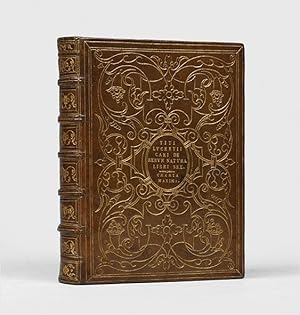
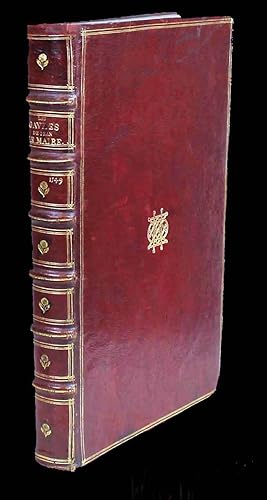
![Image du vendeur pour Poliphili hypnerotomachia, ubi humana omnia non nisi somnium esse ostendit, atque obiter plurima scitu sane quam digna commemorat [La hypnerotomachia di Poliphilo, cioè pugna d'amore in sogno]. mis en vente par Bernard Quaritch Ltd ABA ILAB](https://pictures.abebooks.com/inventory/md/md31128458528.jpg)

